Vietnamese Culture: History, Traditions, Values, Customs, Beliefs, Food & More

A lively street scene in Vietnam during a cultural festival. - Tet Nguyen Dan
Vietnamese culture is among the oldest in Southeast Asia, with its roots tracing back to the ancient Đông Sơn civilization during the Bronze Age, around four thousand years ago. While some perceive a strong Chinese influence, scholarly research indicates that Vietnamese culture developed its own distinct characteristics, evolving alongside but independently from its northern neighbor. Throughout Vietnam’s history-marked by the Triệu, Đinh, Lý, Trần, and Lê dynasties, which largely coincided with the Chinese Han, Tang, Song, and Ming dynasties – a unique cultural identity took shape.
The foundation of this identity is often attributed to the ancient kingdom of Nam Việt, inhabited by the Giao Chỉ people. Archaeological findings suggest that Nam Việt shared some cultural traits with Han Chinese cultures but was firmly rooted in the indigenous Đông Sơn culture, renowned for its sophisticated bronze-casting techniques, as exemplified by the iconic Đông Sơn drums. In 111 BC, Nam Việt was conquered by the Han Dynasty, initiating the first period of Chinese domination that lasted for over a millennium. This era undeniably introduced Chinese influences, particularly Confucian philosophy in governance and certain artistic styles.
However, following independence in the 10th century, successive Vietnamese imperial dynasties fostered a cultural renaissance. The southward expansion of the Đại Việt kingdom, incorporating territories from the Champa and Khmer civilizations, further enriched Vietnamese culture, leading to the regional variations observed today. The French colonial period, beginning in the mid-19th century, introduced European influences, most notably in architecture, the adoption of Catholicism, and the Latinization of the Vietnamese script, replacing the traditional Chinese characters (Chữ Hán) and the demotic Nôm script.
After the departure of the French in 1954 and the subsequent period of division, Vietnamese culture in the North was shaped by government-sponsored cultural programs that emphasized connections with fellow communist nations like the Soviet Union, China, and Cuba. However, since the Đổi Mới economic reforms in 1986, Vietnam has embraced a more open cultural exchange, absorbing diverse influences from across Asia, Europe, and the Americas, adding further layers to its already rich cultural tapestry.
Central to Vietnamese culture is the high value placed on the family unit. It is a society that emphasizes nurturing the young and honoring elders as fundamental duties. The prevalence of multi-generational households underscores the deep-seated importance of familial bonds. “Face” concept also plays an important role in social interactions.
Respect for elders, a reverence for food as a cultural cornerstone, and maintaining a serene composure – often referred to as “keeping a cool head” – are pillars of Vietnamese values. Loyalty and respect within the family are paramount, deeply influenced by Confucian principles. These principles, adopted by many Vietnamese, promote a way of life that emphasizes harmony, community, and moral conduct.
Vietnamese culture is rich in symbolism. Four mythical creatures – the Dragon, Turtle, Phoenix, and Unicorn – hold special significance, representing power, longevity, nobility, and peace, respectively. The lotus, revered for its beauty and purity, is recognized as the national flower, while bamboo, known for its strength and flexibility, is considered the most popular plant in Vietnam and a symbol of resilience.
Table of Contents
- Exploring Traditional Vietnamese Culture: Values, Customs, and Beliefs
- Ethnic groups in Vietnam
- Social Beliefs & Customs in Vietnam
- Vietnamese Cuisine
- Traditional costumes of Vietnam
- Religion and philosophy of Vietnam
- Vietnamese Music & Dance
- Vietnamese Arts & Literature
- Martial Arts in Vietnam
- Festivals of Vietnam
- Holidays and other important days
Exploring Traditional Vietnamese Culture: Values, Customs, and Beliefs
Traditional Vietnamese culture is a rich tapestry woven from centuries of indigenous practices, external influences, and a deep reverence for family, community, and harmony. Understanding the core values, customs, and beliefs that underpin this vibrant culture is essential to appreciating its unique character and navigating social interactions in Vietnam.
Family as the Cornerstone:
At the heart of Vietnamese society lies the family unit. Unlike the individualistic focus prevalent in some Western cultures, Vietnam emphasizes collectivism, with the family’s well-being and reputation prioritized above individual desires. Multi-generational households are still common, especially in rural areas, fostering strong bonds between grandparents, parents, and children. Elders are deeply respected for their wisdom and experience, and their guidance often plays a significant role in family decisions. This strong emphasis on familial ties is rooted in Confucian principles, which have profoundly shaped Vietnamese social structure and continue to influence daily life. Filial piety, the virtue of respect for one’s parents, elders, and ancestors, is a cornerstone of this value system.
Core Values:
Beyond the family, several core values permeate Vietnamese culture:
- Respect (Sự Tôn Trọng): Respect is paramount in all social interactions, demonstrated through polite language, deference to elders, and an awareness of social hierarchy. Addressing people with appropriate titles and using honorifics is crucial.
- Harmony (Hài Hòa): Maintaining harmony in relationships and avoiding conflict are highly valued. Vietnamese people often prioritize smooth social interactions over direct confrontation. This relates to the concept of “face,” where preserving one’s dignity and social standing is of utmost importance.
- Learning and Education (Sự Học): Education is highly regarded in Vietnam. Academic achievement is seen as a pathway to social mobility and a source of pride for families. This value is also connected to Confucian ideals.
- Community (Cộng Đồng): A strong sense of community and mutual support exists in Vietnam. Neighbors often assist one another, and collective activities are common.
Customs and Traditions:
Vietnamese customs are a vibrant blend of indigenous practices and influences from China, and to a lesser extent, France. Some notable customs include:
- Ancestor Worship (Thờ Cúng Tổ Tiên): This deeply ingrained practice involves honoring deceased ancestors through rituals, offerings, and prayers. Most Vietnamese homes and businesses have ancestral altars, where incense, food, and flowers are offered regularly, especially during important anniversaries and festivals like Tết. Ancestors are believed to continue to influence the lives of the living, offering protection and guidance.
- Tết Nguyên Đán (Lunar New Year): The most important festival in Vietnam, Tết is a time for family reunions, paying respects to ancestors, and celebrating new beginnings. It’s marked by vibrant decorations, special foods like bánh chưng (sticky rice cakes) and bánh tét, and the giving of lucky money (lì xì) in red envelopes.
- Mid-Autumn Festival (Tết Trung Thu): Celebrated on the 15th day of the 8th lunar month, this festival is particularly popular with children. It features colorful lantern processions, lion dances, and the sharing of mooncakes, symbolizing fullness and unity.
- “Face” Concept: The concept of “face” is crucial in social interactions. Maintaining one’s own and others’ “face” involves avoiding actions that could cause shame, embarrassment, or loss of dignity. This often leads to indirect communication and conflict-avoidance strategies.
Spiritual Beliefs:
While officially an atheist state, Vietnam recognizes six religions: Buddhism, Catholicism, Protestantism, Islam, Cao Dai, and Hoa Hao. However, the spiritual landscape of Vietnam is largely defined by the “Tam Giáo,” a syncretic blend of Mahayana Buddhism, Confucianism, and Taoism, often intertwined with indigenous animist beliefs and ancestor worship. This complex interplay of beliefs shapes ethical values, social norms, and daily practices for many Vietnamese. Many Vietnamese, regardless of their formal religious affiliation, practice ancestor worship and may visit temples or pagodas to pray for good fortune, health, and success.
Key Takeaways:
Vietnamese culture is rich and diverse, shaped by a blend of indigenous traditions and foreign influences, including Chinese, Khmer, and French. It is rooted in the Đông Sơn civilization and emphasizes harmony between humans and nature. At its core, Vietnamese culture values family, respect, harmony, and community, which deeply shape social interactions and traditions. Ancestor veneration plays a central role in spiritual life, reflecting a belief in the continuity between this life and the other world, which significantly influences daily practices. The 54 ethnic groups in Vietnam contribute to its vibrant cultural tapestry, with unique art forms like silk painting and water puppetry, a cuisine celebrated for its fresh ingredients and balanced flavors, and traditional festivals such as Tết (Lunar New Year). Despite modernization and global engagement, these traditions and values remain deeply ingrained, making Vietnam a country of profound cultural heritage and identity.
Ethnic groups in Vietnam
Vietnam is a multiethnic country with over fifty distinct groups (54 Totally). Each of them has its own language, lifestyle, and cultural heritage. Many of the local ethnic groups residing in mountain areas are known collectively in the West as Montagnard or Degar.

Representatives from various ethnic groups in Vietnam, showcasing their unique traditional attire.
The largest ethnic groups are: Kinh (Viet) 85.7%, Tay 1.9%, Tai Ethnic 1.8%, Mường 1.5%, Khmer Krom 1.5%, Hmong 1.2%, Nung 1.1%, Hoa 1%, with all others comprising the remaining 4.3% (2009 census). The Vietnamese has term for ethnic group (literally “minority people”). One distinctive feature of highland ethnic minority groups in Vietnam is that they are colorfully attired whether at home, in the farm, traveling or in their home town.
Many ethnic groups elsewhere such as southern part of Vietnam, Cambodia, Laos, Myanmar, China, Papua New Guinea, and many other countries do not wear attractive clothes while engaged in their day-to-day activities. The clothing of one group is quite different from that of other groups and adds color to the social landscape. When you travel in Vietnam, you will meet and even talk to many of them. In the trip to Sapa, you may see dozens of them or some province as Lai Chau has 20 ethnic groups ( more than 3 hundreds thousand habitats). Dak Lak province has most in Vietnam with 47 ethnic groups.
Vietnam boasts a stunning diversity of ethnicities, creating a rich cultural tapestry. Over 54 ethnic groups are officially recognized in Vietnam, each with its own unique traditions, languages, and customs. The Kinh (Viet) ethnic group makes up about 86% of the population. But venture beyond the Kinh majority, and you’ll discover a mosaic of fascinating ethnic minorities.
Here are some of the major ethnic groups in Vietnam:
- Kinh (Viet): The dominant ethnic group, also known as Vietnamese.
- Tay: Renowned for their distinctive stilt houses, a must-see for any visitor to Northern Vietnam.
- Thai: Celebrated for their vibrant textiles and beautiful clothing.
- Hmong: Masters of embroidery and silversmithing, their handicrafts are a treasured souvenir.
- Dao: Skilled artisans, famous for their indigo-dyed fabrics.
This is just a glimpse into the rich ethnic landscape of Vietnam. Each group has its own story to tell, adding another layer of fascination to this captivating country. So, explore Vietnam’s ethnic tapestry and discover the cultural gems hidden within its diverse communities!
Social Beliefs & Customs in Vietnam
Family is very strong in Vietnam. Family and clan (dòng họ) are valued over individualism. Clan is the most important social unit in the country and each clan features a patriarch heading the clan and a clan altar. Even today, in some parts of the country, the tradition of clan members living together in longhouses is quite prevalent. It is also not uncommon to see three to four generations of a family living together in the same house. Members of a clan are related by blood and often name their villages based on their clan names. Death commemorations of clan members are usually attended by all members of the clan and villagers.
Weddings in Vietnam earlier was arranged mainly by parents and people were married very young. However, things have changed so much in recent years since Vietnam Open the door to the World and tourism pick up in early of 90. Vietnamese youth enjoy greater freedom of choosing the time of their marriage and their partner. Weddings are still mostly held in the traditional manner with elaborate rituals and ceremonies. The date for Wedding was carefully selected by Feng Shui master or most respected man in the Clan.
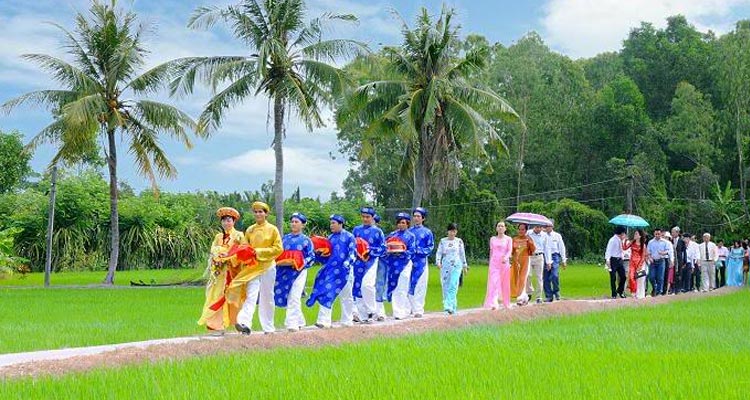
The traditional funeral ceremony in Vietnam is also quite elaborate and long-stretched. The body of the dead person is cleaned with fragrant water and dressed carefully in the special clothes. A lot of mourning following and depends on each tribe and location, they have the slightly different ceremony. Later the body will be burying, the most popular method. Recently, some area, people choose cremation instead of burying. Only 1 case of remains in frozen condition and several cases of Monks body was kept inside the statues…
According to Confucian, men and women can not touch hand unless they are husband and wife so Vietnamese people don’t hug when meeting. They say ” Xin Chao” or handshake between men.
People in the city talk gently and quietly and people come from the countryside or from the sea talk pretty loud. They work on the farm or ocean and they got to talk even louder than the wind or the waves.
Understanding social etiquette is important when visiting Vietnam. You can learn more about Vietnamese customs and etiquette in our Essential Guide to Customs and Etiquette in Vietnam.
Traditions in Vietnam
Vietnam’s rich cultural tapestry is woven with traditions that reflect its vibrant history and diverse heritage. At the heart of Vietnamese life is the Lunar New Year, or Tết Nguyên Đán, a time when families reunite to honor ancestors and celebrate new beginnings. This reverence for forebears extends beyond the holiday, with many homes featuring altars for regular ancestral offerings.
Another cherished tradition is the Mid-Autumn Festival, where children’s laughter mingles with the glow of lanterns and the sweetness of mooncakes.
Vietnam’s sartorial heritage shines through in the elegant áo dài, often donned for special occasions. The country’s artistic spirit comes alive in unique water puppetry performances, while traditional music and dance add rhythm to cultural expressions. Vietnamese cuisine, a delightful balance of flavors and fresh ingredients, is more than sustenance—it’s a proud cultural ambassador. From the aromatic phở to the crusty bánh mì, each dish tells a story of Vietnam’s culinary traditions.
These customs, along with tea ceremonies and martial arts, underscore the nation’s deep-rooted respect for family, heritage, and cultural identity, inviting both locals and visitors to experience the warmth and richness of Vietnamese traditions.
Vietnamese traditions are a vibrant blend of ancient customs, communal values, and unique celebrations that reflect the country’s rich history and diverse cultural heritage. Here are some of the most notable traditions in Vietnam:
- Tết (Vietnamese Lunar New Year): Tết marks the arrival of spring and is the most important holiday in Vietnam. Families gather to clean their homes, prepare special foods, and honor their ancestors with offerings and prayers.
- Veneration of the Dead (Ancestor Worship): Honoring ancestors is a core aspect of Vietnamese culture. This deep-seated tradition involves maintaining home altars where they offer incense, food, and prayers and performing rituals to honor deceased family members, showcasing the respect for family and lineage.
- Mid-Autumn Festival (Tết Trung Thu): Celebrated on the 15th day of the 8th lunar month, this festival is for children. It features lantern processions, lion dances, and mooncakes to celebrate the harvest and the full moon.
- God of Wealth (Thần Tài): On the 10th day of the lunar year, businesses and households worship the God of Wealth to attract prosperity and good fortune for the year ahead.
- Communal dining: Food is a big part of Vietnamese culture, and meals are often seen as a time to bond with family and friends. Sharing dishes from a communal plate in the center of the table is a common practice.
- Respect for elders: Age is highly respected in Vietnamese society, and younger people are expected to show deference to their elders. This is reflected in greetings, conversation, and decision-making.
- Tea culture: Tea is a beloved beverage in Vietnam, and drinking tea is seen as a way to relax, socialize, and bond with others.
- Visiting Pagodas: Regularly visiting pagodas and temples is a common practice in Vietnam, reflecting the strong influence of Buddhism, Taoism, and Confucianism in Vietnamese spirituality.
- Vietnamese People Are Relentlessly Optimistic: Despite hardships, Vietnamese people are known for their unwavering optimism and resilience, which is reflected in their cultural expressions and daily life.
- Hùng Kings’ Festival: This festival commemorates the legendary Hùng Kings, the traditional founders of Vietnam. It includes ceremonies, traditional games, and performances to honor these ancient rulers.
- Khau Vai Love Market: An annual event where ethnic minority groups gather in Khau Vai village to celebrate love and reunite with past lovers, reflecting the unique social customs of the region.
- Perfume Pagoda Festival: Taking place from the first to the third lunar month, this pilgrimage involves a journey to the Perfume Pagoda, where devotees pray for health, prosperity, and happiness.
Vietnamese traditions are a beautiful mosaic of rituals, festivals, and social customs that bind the community together and celebrate life’s significant moments. These traditions offer a window into the soul of Vietnam, where the past and present harmoniously coexist.
Vietnamese Cuisine

Vietnamese food is fresh and healthy and getting more and more popular all over the World. It exhibits great diversity but can be classified into three primary categories by locations: the north, south, and central regions of the country. Many types of noodles and noodle soups and all type of spring rolls are popular here. Less use of oil and greater use of fresh vegetables is preferred. Soy sauce, fish sauce, mint, and basil are popular ingredients. Rice is the main food and eaten in 3 meals a day. The flavors of Vietnamese food range from spicy and sour to sweet. The Noodle Soup originating in North Vietnam is a noted Vietnamese dish and features rice noodles with beef, chicken, fish, sea food…. soup and scallions or bean sprouts as accompaniments. There is vegetarian noodle soup too.
Vietnamese cuisine is an explosion of fresh flavors and vibrant textures, a delightful dance on your taste buds. Imagine fragrant bowls of pho, steaming hot and brimming with rice noodles, succulent meats, and a rich, aromatic broth. Or picture crusty banh mi sandwiches, filled with savory meats, pickled vegetables, and a touch of creamy pate.
Vietnamese cooking boasts a beautiful regional diversity. In the north, dishes lean towards lighter broths and fresh herbs. Central Vietnam cranks up the heat with chilies and spices, while the south features a touch of sweetness and bolder flavors.
Here’s a taste of what awaits you:
- Pho: The national treasure, pho is a fragrant noodle soup with a rich beef broth, rice noodles, thinly sliced meat (often beef), and a vibrant array of fresh herbs and vegetables.
- Banh Mi: The quintessential Vietnamese street food, banh mi is a crusty baguette stuffed with savory fillings like pate, grilled meats, pickled vegetables, fresh herbs, and a touch of chili sauce for a flavor explosion.
- Bún Chả: This dish features grilled, marinated pork served with vermicelli noodles, fresh herbs, and dipping sauce for a refreshing and flavorful experience.
- Gỏi Cuốn (Spring Rolls): Fresh and light, these spring rolls are packed with rice noodles, herbs, vegetables, and sometimes shrimp or pork, all wrapped in a thin rice paper sheet and dipped in a flavorful peanut sauce.
Traditional costumes of Vietnam

54 tribes in Vietnam has their own traditional costumes. The traditional dress of the Vietnamese people changed significantly from time to time and depended largely on the whims and fancies of the region’s rulers. The common people of the country had greater freedom to choose their clothing prior to the Nguyen dynasty. During Nguyen Dynasty, several restrictions were placed on the type and colors of clothes that could be worn by the common people of Vietnam.
Some of the examples of traditional Vietnamese costumes are the Áo Giao Lĩnh, the Áo Tứ Thân, Áo Cánh, and the Áo Bà Ba. The first one refers to a cross-collared robe worn by the Vietnamese men while the second is a four-part dress worn by the women.
The last two dresses were worn by the peasants in the north and south, respectively and appeared like silk-pajama-type costumes. The color code of the dresses also varied from time to time and during Nguyen dynasty, only the monarchs enjoyed the exclusive rights of wearing golden clothes while purple and red were popular among the nobles and aristocrats. The headgear worn in Vietnam changed over the years with the conical hat or Non La being the most popular among the community.

Beautiful Vietnamese girls in Ao Dai ( long dress) at Hue Citadel
Traditional Vietnamese costumes reflect the rich cultural heritage and diversity of Vietnam’s various ethnic groups. The most iconic is the “ao dai,” a graceful, long tunic worn over trousers, often made from silk and adorned with intricate embroidery. The ao dai is typically worn during special occasions, weddings, and festivals, symbolizing elegance and femininity.
For men, the “ao gam” is a traditional robe, usually worn with loose pants, featuring bold, symmetrical patterns.
In the northern regions, the “quan ho” singers wear “ao tu than,” a four-piece dress, showcasing the rustic charm of the countryside. Meanwhile, the Hmong people in the highlands sport vibrant, hand-embroidered garments with intricate motifs, reflecting their close-knit community and traditions.
Vietnam’s traditional costumes not only enhance the beauty of the wearer but also tell stories of the country’s rich history and cultural diversity.
Religion and philosophy of Vietnam
Most of Vietnamese people worshiping their ancestors and believe in animism. In the ID most of Vietnamese (about 90%), the line: Religion: None.
In reality, religion in Vietnam has historically been largely defined by a mix of Buddhism, Confucianism, and Taoism, known in Vietnamese as the Tam Giao (“triple religion”). Catholicism is also practiced in modern Vietnam.
Ancestor worship is common in Vietnamese culture. Most Vietnamese, regardless of religious denomination, practice ancestor worship and have an ancestor altar at their home or business, a testament to the emphasis Vietnamese culture places on filial piety
Vietnamese Music & Dance
Vietnam is associated with a rich tradition of dance and music. Vietnamese music also exhibits variance in each part of Vietnam. It is older and more formal in the north while Champa culture exerts considerable influence on Central classical music and music in the southern part of the country is a livelier affair. The country has nearly 50 national music instruments. The Imperial Court music and the Ca Tru are important traditional forms of Vietnamese music.
The great ethnic diversity of Vietnam has gifted the country with diverse dance forms. These dances are usually performed at the cultural programs and festivals held in the country. The Lion dance, platter dance, fan dance, imperial lantern dance is some of the traditional dance forms of Vietnam. The dances that developed in the imperial courts of Vietnam are quite complex in nature and require great skills to be mastered.
Vietnamese Arts & Literature
Literature in Vietnam has greatly evolved over the years from romanticism to realism. Two aspects of the literature in the country are the folk literature and the written literature both of which developed almost at the same time. Folk literature features fairytales, folk legends, humorous stories, and epic poems. Written literature was previously written in the Cham and Nom characters and focused on poetry and prose. Now, it is mostly written in the National Language and includes short stories, dramas, novels, etc.
Vietnamese art is mainly influenced by Buddhism, Taoism, and Confucianism. However, more recently, the Cham and French influence have also been reflected in the art presentations. Silk painting is popular in Vietnam and involves the liberal use of colors. Calligraphy is also a much-respected art form and often, during festivals like the Lunar New Year. On the third day of new year people would visit a village teacher or an erudite scholar to obtain calligraphy hangings for their homes. Vietnamese wood-block prints are also quite popular. Water puppetry and several forms of theaters represent other performing art forms in Vietnam.
Martial Arts in Vietnam
Vovinam ( Viet Vo Dao) is Vietnam traditional martial art. Vietnam has a very well-developed tradition of martial arts that has some similarity to Chinese martial arts. Vietnamese Vovinam martial arts philosophy guides the martial arts practice in the country. It is associated with intense spirituality because of its close association with Buddhism, Taoism, and Confucianism. The scissor kick is a famous movement of this form of martial arts.
Although Vietnamese martial arts is less popular in other parts of the world than its Chinese or Japanese counterparts, there is no doubt that it is gradually and steadily gaining greater popularity worldwide with the establishment of schools teaching this martial art form in many parts of the world.
Vietnamese martial arts, known as “Võ thuật Việt Nam,” offer a rich tapestry of history, culture, and diverse techniques. Rooted in ancient traditions and the country’s turbulent history, these martial arts emphasize both physical prowess and mental discipline. Styles such as Vovinam, Bình Định, and Võ Cổ Truyền are prominent, each with unique characteristics. Vovinam, for instance, incorporates a mix of hard and soft techniques, including grappling and weaponry, while Bình Định is famed for its dynamic footwork and powerful strikes. Vietnamese martial arts not only teach self-defense but also promote physical fitness, self-confidence, and respect. Whether practiced for sport, self-defense, or personal growth, they offer a holistic approach to martial arts, blending strength, agility, and a deep cultural heritage.
Festivals of Vietnam

Vietnam has many festivals. In Vietnamese Festival is Le Hoi. It includes 2 parts Le: Ceremony + Hoi: Game & fun.
Festivals including both traditional ones and those adopted from other cultures are celebrated in the country with great pomp and glory. Here is the top 10 festivals in Vietnam:
- 1 -TET Nguyen Dan – TET holidays all over the country
- 2- Hung King Holidays in March 10th ( lunar calendar)- Phu Tho province
- 3- Saint Giong Festival – In March outside Hanoi in Soc Son district
- 4- Ka Te Festival – In Champa community in Ninh Thuan Province
- 5- Perfume pagoda festival – Outside Hanoi
- 6- Dong Da Festival in Hanoi
- 7- Cau Ngu Festival in Hue in December
- 8- Hội đua voi – Elephant racing in Don village – Dak Lak province
- 9- Ba Chua Xu Festival – In Chau Doc city, An Giang province in April
- 10- Cam Muong Festival in Lai Chau province.
Holidays and other important days
Vietnam’s charm goes beyond its postcard-worthy landscapes. Dive into the heart of Vietnamese culture through its captivating holidays and celebrations!
- Tết Nguyên Đán (Lunar New Year): Imagine a week-long extravaganza welcoming spring! Tet, the most important Vietnamese holiday, explodes with vibrant flower markets, firecracker displays that banish bad luck, and ancestor veneration ceremonies. Think delicious feasts featuring bánh chưng (sticky rice cakes) and lucky red envelopes bursting with wishes for prosperity.
- Hung Kings Commemoration Day (Mar 10th Lunar Calendar): Honoring the legendary founders of Vietnam with elaborate ceremonies.
- Liberation Day and Reunification Day: April 30th and May 1st are days that commemorate the reunification of North and South Vietnam in 1975. These holidays are marked with parades, cultural performances, and fireworks, reflecting Vietnam’s journey towards unity and independence. It’s a time to reflect on the country’s history and celebrate its resilience and progress.
- National Day (September 2nd): Step back in time and witness the national spirit soar! Every September 2nd, Vietnam commemorates its Declaration of Independence with parades, flag raisings, and cultural performances. It’s a powerful reminder of the country’s resilience and a chance to witness the national pride in full swing.
- Beyond Public Holidays: Vietnam’s calendar is sprinkled with other cultural gems. Celebrate the harvest moon with the Mid-Autumn Festival, where streets come alive with colorful lanterns and children carry lion dances. Or, delve into the spiritual realm during the Đền Hùng Festival, honoring the legendary Hùng Kings, the ancestors of the Vietnamese people.
Vietnam’s holidays offer a unique glimpse into its soul. Remember, some holidays (like Tet) can cause business closures and transportation snags. When planning your trip to Vietnam, consider timing your visit to coincide with these vibrant holidays and festivals. Whether you’re exploring bustling city streets, tranquil countryside, or scenic coastlines, experiencing these celebrations firsthand will immerse you in the heart and soul of Vietnam.
Vietnam holidays are a blend of ancient customs and modern celebrations, offering travelers a profound cultural experience. From the iconic Tet celebrations to the festive lantern-lit streets during Mid-Autumn Festival, each holiday paints a colorful picture of Vietnam’s rich heritage. Plan your journey to Vietnam, and let these vibrant holidays become cherished memories of your travels in Southeast Asia.
Experience the magic of Vietnam—where every holiday is a celebration of culture, community, and the spirit of a nation. Start planning your Vietnam holiday today and discover why this country’s festivities are truly unforgettable.


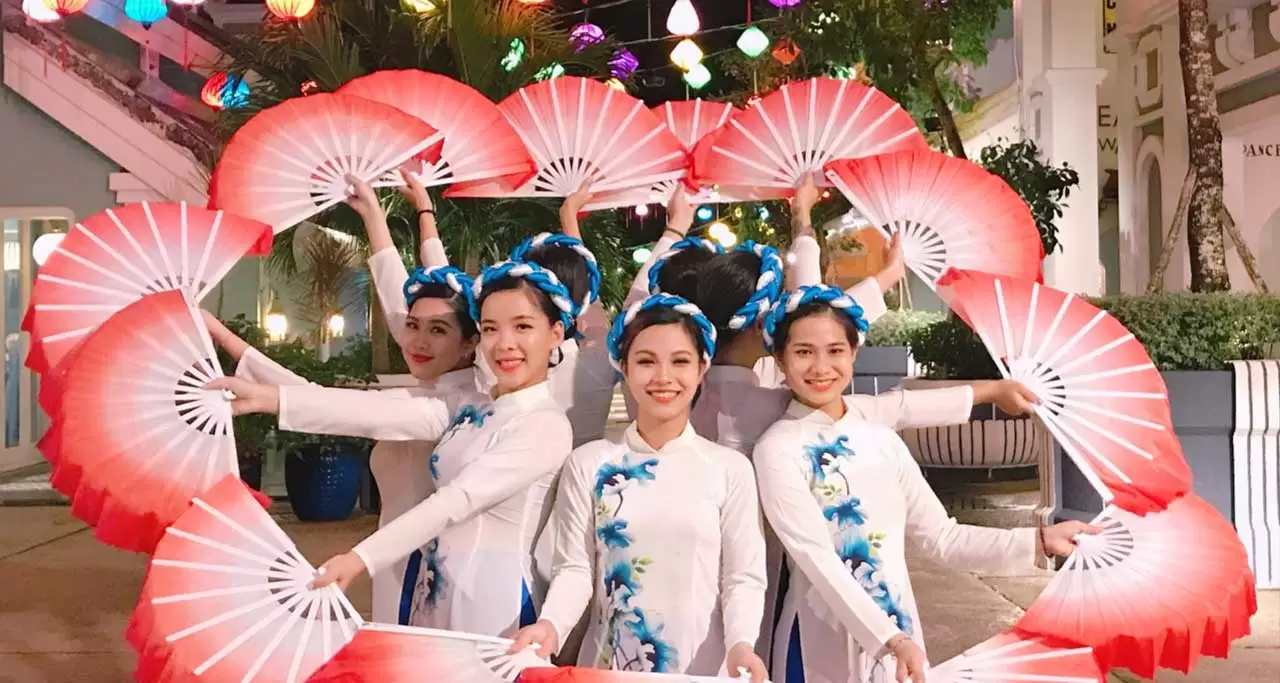


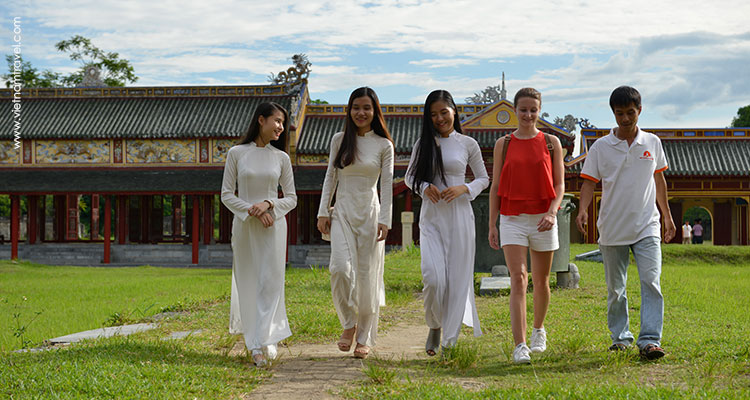






















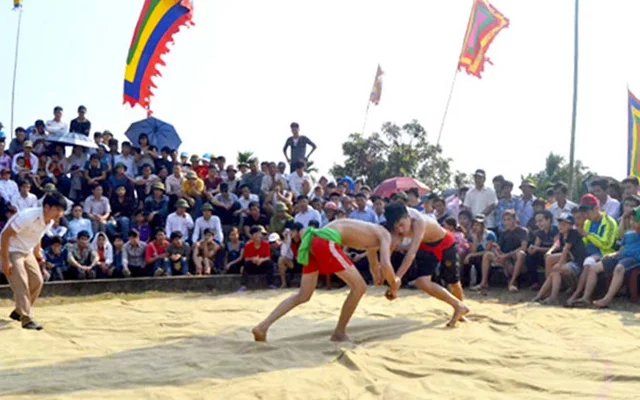
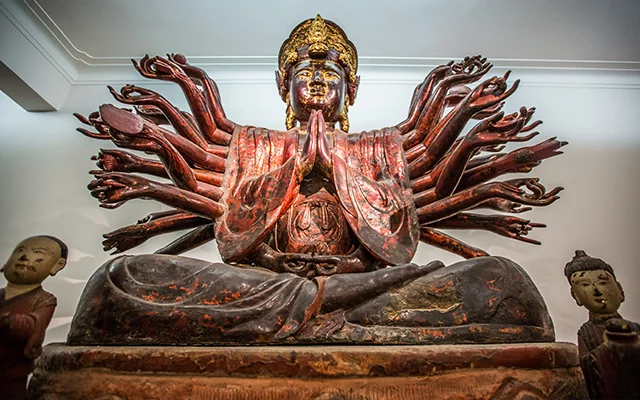
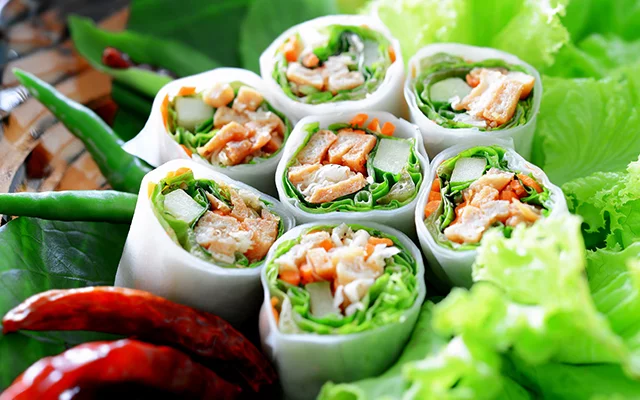


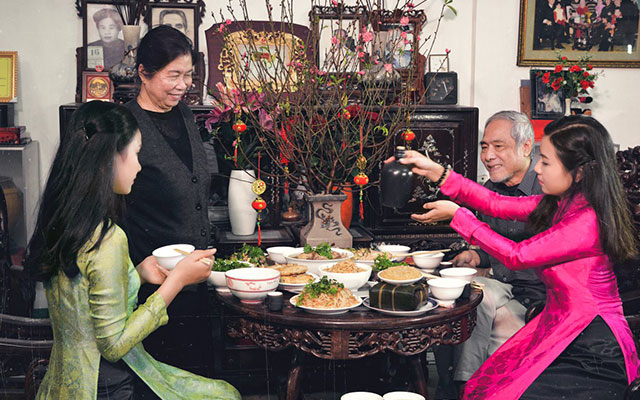









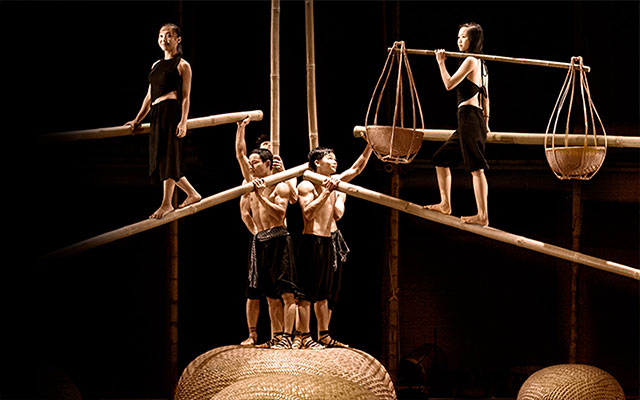




It is amazing
Me to!
I agree
Wonderful research. However, in topic 3, Vietnamese Cuisine, in line 3 sentence 3 word 10 (TYPE in “…noodle soups and all TYPE of spring rolls are…”), I think is supposed to be types, as in “…noodle soups and all types of spring rolls are…”.
Great!
Detailed article but there are still some grammar and spelling mistakes. Great job on the research though
Really awesome